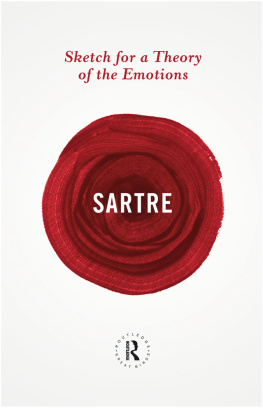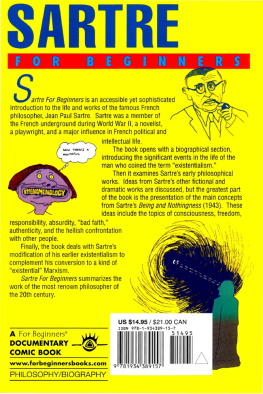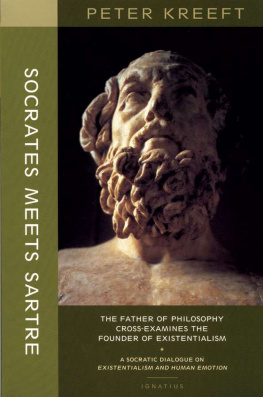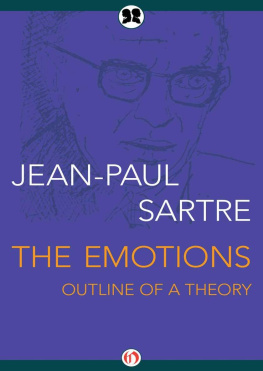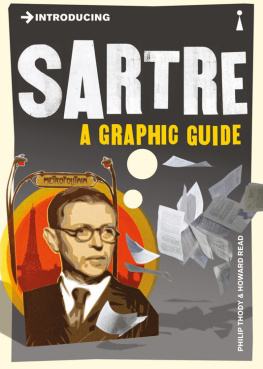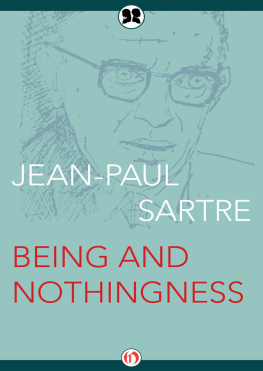Sketch for a Theory of the Emotions
Jean-Paul Sartre was one of the great philosophers of the twentieth century. Also a renowned novelist, dramatist, political activist and literary critic, his work brought the philosophy of existentialism to worldwide attention.
Born in Paris on 21 June 1905, he was the only child of Jean-Baptiste Sartre, an officer of the French Navy, and Anne-Marie Schweitzer. When Sartre was two his father died and his mother returned to her parents house in Meudon, a suburb of Paris. She raised Sartre there with the help of her father, a German teacher who instructed Sartre in mathematics and introduced him to classical literature. In 1909 Sartre suffered from leucoma in his right eye, which in Sartres words would lead him to be half-blind and wall-eyed. In 1911, his family left Meudon and went to live in Paris. When he was twelve, Sartres mother remarried, and the family moved to La Rochelle, on the west coast of France. Sartre later recalled his early love of reading and writing in his autobiography, Les Mots (The Words).
As a teenager in the 1920s, Sartre was drawn to philosophy after reading Henri Bergsons Time and Free Will. He earned a degree in philosophy in Paris at the cole Normale Suprieure in 1929. It was here that he met Simone de Beauvoir, who studied at the Sorbonne. The two became extremely close and formed a lifelong companionship. They questioned the assumptions of their upbringings, which they considered constrained and privileged. This conflict between thoughtless conformity, which Sartre famously termed bad faith, and an authentic way of living was a dominant theme of Sartres early work.
In 1939 Sartre served as a meteorologist in the French army. Captured by German troops in 1940 in Padoux in north eastern France he spent nine months as a prisoner of war. During his imprisonment he read Martin
Heideggers Being and Time , which, whilst Sartre took issue with some of its conclusions, was a significant influence on his philosophy. Due to his poor health and eyesight Sartre was released in April 1941. He returned to Paris in the same year and immediately set about helping to found the underground group Socialisme et Libert . Lacking sufficient support it soon broke up. Sartre decided to write instead of being involved in active resistance. His major philosophical work Being and Nothingness was published in 1941 and two plays, The Flies and No Exit, followed in 1943 and 1944 respectively.
After the liberation of Paris in 1944 Sartre wrote Anti-Semite and Jew , a work of non-fiction in which he explored anti-Semitism through four typically Sartrean characters: the anti-Semite, the democrat, the authentic Jew and the inauthentic Jew. He was also a contributor to Combat , a newspaper created by Albert Camus during the German occupation. Later, the French philosopher and resistant Vladimir Jankelevitch criticized Sartres lack of political commitment during the occupation, interpreting his political writings as an attempt to assuage his guilt. According to Camus, Sartre was a writer who resisted, not a resister who wrote.
After the war ended Sartre established Les Temps Modernes , a quarterly literary and political review. He drew on his experience of war for his great trilogy of novels, Les Chemins de la Libert (The Roads to Freedom), published between 1945 and 1949. His play Les Mains Sales (Dirty Hands) (1948) explored a typical Sartre theme: the dilemma of the politically engaged intellectual. He strongly opposed French rule in Algeria as did many intellectuals of the time. His support of the FLN in Algeria made him a domestic target of the paramilitary Organisation de larme secrte (OAS) and he escaped two bomb attacks in the early 1960s. He opposed the Vietnam War and, along with Bertrand Russell and others, organized a tribunal intended to expose US war crimes, which became known as the Russell Tribunal, in 1967.
The first volume of Critique de la raison dialectique (Critique of Dialectical Reason) appeared in 1960. Sartre argued that Marxs notion of class as objective was wrong and he attempted to provide a new philosophical foundation for Marxism. Never a member of the Communist party, Sartres emphasis on humanism in Marxs work led to a quarrel with Louis Althusser, one of Frances radical left-wing intellectuals. However, Sartre visited Cuba in the 1960s where he met with both Fidel Castro and Che Guevara. After Guevaras death, Sartre said he was not only an intellectual but also the most complete human being of our age.
In October 1964, Sartre was awarded the Nobel Prize in Literature but he declined it; because in his view the personal commitments of a writer should not be associated with institutions. He was the first Nobel Laureate to voluntarily decline the prize, having previously refused the Lgion dhonneur in 1945. He remained committed to political causes until the end
of his life. During the strikes and social protests of 1968 he was arrested for civil disobedience. He was swiftly pardoned by President Charles de Gaulle, who said you dont arrest Voltaire.
Sartres health began to collapse whilst he was composing a huge biography of Gustave Flaubert, which remained unfinished. He became almost completely blind in 1973.
Sartre died on 15 April 1980 in Paris from edema of the lung. His funeral attracted an enormous crowd of up to 50,000 mourners, who accompanied his coffin to the Cimetire de Montparnasse in Paris where he is buried.
Sebastian Gardner s main interests lie in the history of philosophy, in particular Kant, German idealism and phenomenology. His publications include Sartres Being and Nothingness (2009), Kant and the Critique of Pure Reason (Routledge, 1999) and Irrationality and the Philosophy of Psychoanalysis (1993).
Leonardo da Vinci by Sigmund Freud
Letter to a Priest by Simone Weil
Myth and Meaning by Claude Lvi-Strauss
Relativity by Albert Einstein
On Dialogue by David Bohm
Sketch for a Theory of the Emotions by Jean-Paul Sartre
The Sovereignty of Good by Iris Murdoch
The Undiscovered Self by Carl Gustav Jung
Tractatus Logico-Philosophicus by Ludwig Wittgenstein
What I Believe by Bertrand Russell
Jean-Paul Sartre
Sketch for a Theory of the Emotions
Translated by Philip Mairet
The original edition of this work was published in France with the title: Esquisse d'une thorie des emotions by Les Editions Scientifiques HERMANN, 1939. Copyright by Hermann, Paris.
English edition first published 1962
by Methuen & Co. Ltd
First published by Routledge
1994
First published in Routledge Classics 2002
First published in Routledge Great Minds 2014
2 Park Square, Milton Park, Abingdon, Oxon, OX14 4RN
711 Third Avenue, New York, NY 10017
Routledge is an imprint of the Taylor & Francis Group, an informa business
English translation 1962 Methuen & Co. Ltd
2014 foreword, Sebastian Gardner
Typeset in Joanna by RefineCatch Limited, Bungay, Suffolk
All rights reserved. No part of this book may be reprinted or reproduced or utilized in any form or by any electronic, mechanical, or other means, now known or hereafter invented, including photocopying and recording, or in any information storage or retrieval system, without permission in writing from the publishers.

